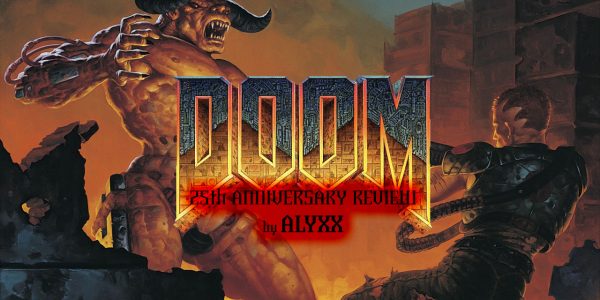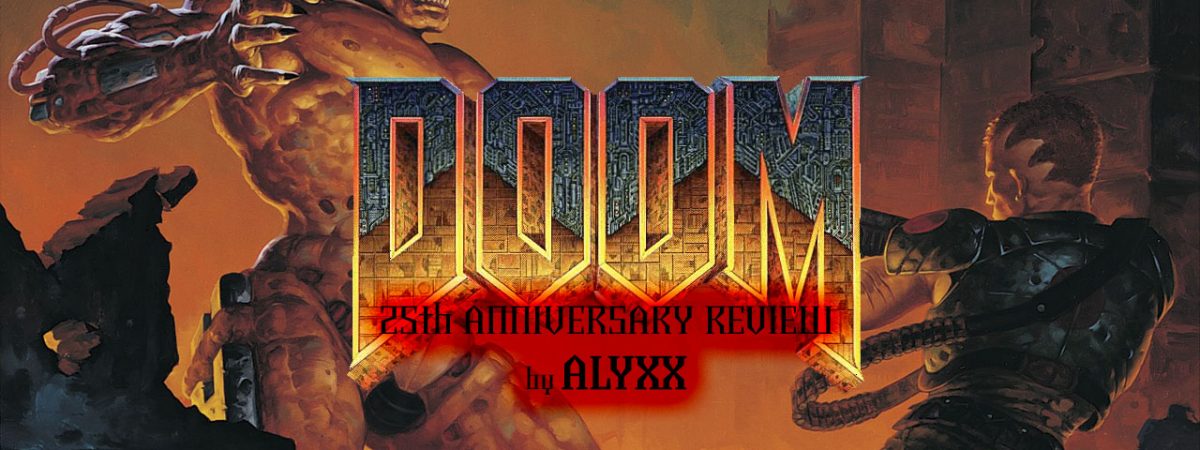GAME: DOOM
RELEASED: 12/10/1993
DEVELOPER: id Software
PUBLISHER: id Software
AVAILABLE ON: PC + all major platforms
1993 was an amazing year. Norwegian electro-rock group Apoptygma Berzerk released their debut album “Soli Deo Gloria”, Intel shipped the first Pentium chips, Windows 3.11 was released and a little game from a small indie developer was released on the 10th of December. The developer was the Texas based “id Software”. The game was simply titled “Doom”.
Leading up to the date, id Software had already released Commander Keen, which became a pretty big hit for the company due to being one of the first PC sidescrollers that actually smoothly scrolled the screen similar to console games like Super Mario Bros. They had also released the grand-daddy of FPS’s, Wolfenstein 3D a mere year earlier. But Wolfenstein 3D would look a generation behind what was to come and the moment Doom released, the hype had already reached a fever pitch. Demos had been released to the press, screenshots had been shown. People already knew that what was to come would be groundbreaking.
The day it released, the server it was hosted on crashed. It became a game that would define the 90’s for gaming as Nirvana’s Nevermind album had for music. It would be installed on more PC’s than Microsoft Windows, prompting Bill Gates himself to acknowledge the game’s immense popularity in a Windows 95 press conference. And it was one of the games that prompted the ESRB rating system to be created. When Doom arrived in December of 1993, the world changed and nothing was ever the same again.
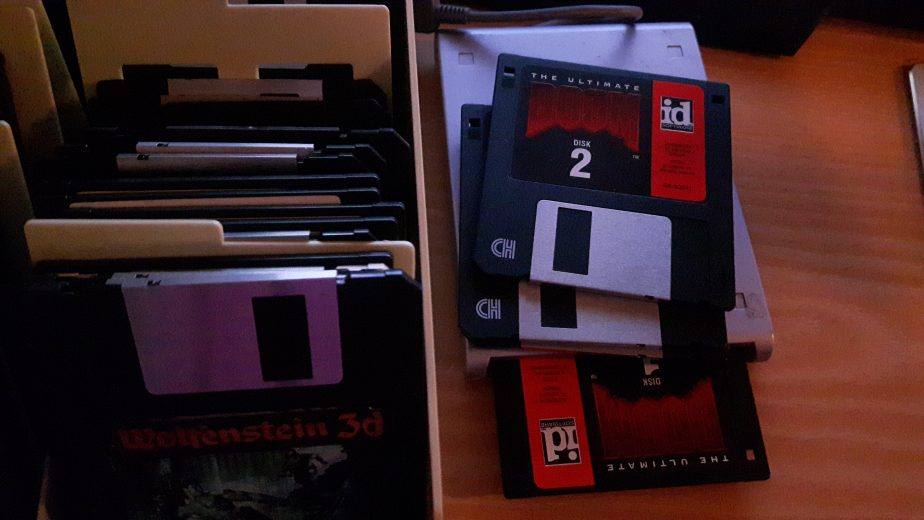
Doom was a groundbreaking title mostly for the technology behind it. Back in the days of the early 90’s, 3D was seen as the next step in gaming. A lot of developers seeked to create a 3D game that could not only deliver a fully 3-dimensional immersive experience, but also run very fast on consumer hardware of the time. Wolfenstein 3D had achieved this by utilizing a technology called raycasting, where it would only draw the parts of the world the player looked at and the rest of it would not be in memory. This had its limitations of course and id Software dropped this engine in favour of something that would make a far more believable 3D world, without actually being 3D.
Due to CPU’s of the time still not being powerful enough to actually draw a true 3D world fast enough, and dedicated GPU’s not having even been made available yet, certain tricks were employed to make the game seem 3D without it actually being it. In reality, what you see on the screen is not actually 3D, but rather a 2D plane that appears 3D. This is why you can’t look up or down in vanilla Doom, and why your aim generally doesn’t matter since if an enemy is in front of you, he’s still on the same plane even if he’s drawn higher up than you.
What this meant for computers at the time was that Doom could run on any standard 486 computer of the time, and it would generally run very fast, and still deliver a world that seemed like true 3D. For many, myself included, playing Doom was like witchcraft. It turned your PC into a dimension to another world. The marine, who was left intentionally nameless (though he’s been affectionately known as Doomguy by the fandom), was meant to be you. Doom transported you into a world of demons, shotguns and heavy metal music unlike any game before it. It sucked you in relentlessly in a mercyless grip. It’s not without reason Doom was banned at several workplaces due to how insanely immersive (and ADDICTIVE) it was at the time.
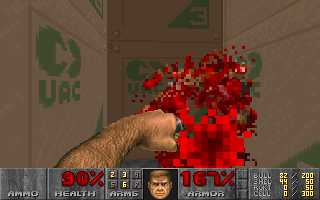
Doom’s story is simple, almost cliché to a point. Science experiments on Mars’ moons Phobos and Deimos have unintentionally opened a portal to hell itself, and hordes of demonic forces have made their way through these portals and either killed everyone or turned them into zombies. Everyone except you. As the lone survivor of the invasion, it is up to you to put an end to it, and shooting, punching, chainsawing, exploding, eviscerating and all around killing every single demon that stands in your way of doing so.
John Carmack has been quoted saying “stories in games are like stories in porn movies; they are nice but ultimately pointless.” And that mantra certainly holds true in Doom as the game is almost solely about its gameplay and the story takes a massive backseat to it, almost feeling trivial as the only story you get are a few text screens at the end of each episode.
Doom is split into 3 episodes, with a 4th episode added in the Ultimate Doom retail release (which is the basis for all future releases of the game on PC).
- Knee Deep In The Dead (shareware episode)
- Shores Of Hell
- Inferno
- Thy Flesh Consumed (Ultimate Doom)
The first 3 episodes are where the main story is and the fourth episode provides little more than some extra levels of extremely high difficulty compared to the main trilogy. It ties losely into the events of Doom 2 but otherwise was probably meant more as a bonus to those who bought the retail release.
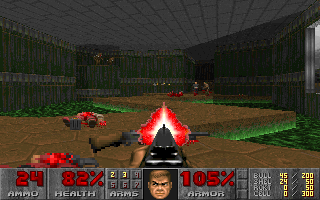
To aid you in the battle for humanity, you have access to an arsenal that would serve as practically the prototype for all future games in the FPS genre. Your fists serve as your last resort, a mostly useless weapon, unless you get yourself a berzerk pack. Your starting gun, a pistol serve as a way of dispatching with the weakest of enemies and is only useful for dealing with zombies. You’ll soon acquire the most iconic weapon of the game and its main workhorse, the shotgun. A weapon that can efficiently deal with most of the game’s enemies and has a lot of ammo available for it.
The chaingun, which you first pick up in E1M2 if you gain access to a secret area, is the game’s main automatic weapon and can easily deal with large groups of enemies. And if you look closely in E1M3 you can pick up your very own rocket launcher. A weapon that can splatter most weaker enemies and deal reliable splash damage to larger enemies. Just make sure you don’t stand too close when firing it as the splash damage applies to you too.
Of course that is just the beginning. Episode 2 also gives you access to the Plasma Rifle, a powerful automatic rifle that can deal with most enemies quickly. And if you are clever you can even get access to the legendary BFG (Big Freakin’ Gun) 9000. A weapon with such devastating power that it can clear an entire room of enemies. In addition to these weapons you can also pick up a chainsaw, which becomes the default weapon on your number 1 key. It’s a more powerful melee weapon that is useful against some enemies that like to get up in your face such as the pinky demons and the spectres.
Guns aren’t the only thing helping you though. In addition you also have numerous powerups. Green armor will boost your armor to a maximum of 100%, while blue armor will boost it up to 200%. A blue sphere will boost your health to 200%. In addition you have the invisibility sphere, which turns you invisible. You have the berzerk pack which turns your fists into some of the deadliest CQC weapons in the entire game, able to splat weaker enemies in a single punch. The radiation suit which protects you against hazardous chemicals, including lava. And finally the invincibility powerup which makes you immune to all damage while it lasts.
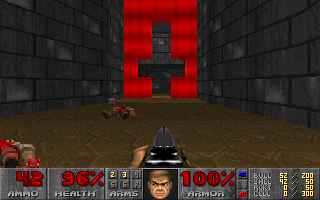
The hordes of hell are definitely not to be trifled with and even if most of the enemies you fight are fairly weak, they do face you in large numbers. Especially if playing on the higher difficulties. Zombies come in two varieties. The normal pistol zombie and the more powerful shotgun sergeant. The shotgun sergeant in particular needs to be a priority in firefights as their shotgun can dish out some serious hitscan damage if you’re not careful. The imp is a fairly weak demon that flings fireballs at you and does claw attacks up close.
The pinky is a lumbering pink (hence the name) beast that likes to run up to your face and eat it off. Spectres are pinkies that are invisible. Barons of hell are towering demons that have more of a typical devil look with goat legs and a bloodcurdling roar. They fling plasma balls and can take quite a beating before going down and two of them serve as the episode 1 boss fight. Later on you’ll face the cacodemon, a floating monstrosity that belches plasma at you.
Boss fights are also a bit of an ordeal in Doom. At the end of episode 2 you’ll be face to face with the Cyberdemon, an enormous towering beast of cybernetics and flesh that fires rockets at you. Best dealt with if you have a BFG-9000 handy. The episode 3 boss is the Spider Mastermind, a frightening demon consisting of a brain with cybernetic spider legs that fires massive gatling guns at you. Both need to be dealt with using superior weaponry and fast skills.
Some of the demons, such as the aforementioned cacodemon, seem to be largely influenced by DND, which is no surprise given that the game started out as a DND campaign the team were playing.
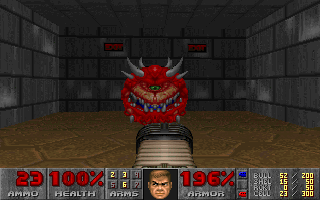
For its time, Doom’s graphics were unparalleled in gaming. It marked the point where consoles could no longer deliver an experience that PC could, although attempts were certainly made given the game’s immense popularity at the time. A lot of it stemmed from the fact that the team put a lot of effort into making its world as realistic as possible with limited resources. Unlike today where everything in a game world is 3D, given the limitations of the engine most of the in-game assets are 2-dimensional sprites and textures. A lot of the textures were made from photo-references of various things. Even a fresh wound from one of the team members was used as a source for one of the textures.
The use of real-life objects also extended to the game’s weaponry and enemies. Several enemies, particularly bosses were modeled out of clay and then digitized into the game to give them a realistic look. And some of the weapons such as the chainsaw and shotgun were photographed from real life props. The shotgun was a toy shotgun they bought at Toys R Us and the chainsaw was borrowed from one of the team members. This immense attention to detail and dedication helped give the world a more realistic feel than most shooters of its time.
The graphical display became another essential part of Doom. Not only displaying all important information about your current state, it also shows a portrait of the helpless dude you’re playing as, and as your health drops the face will get bloodier and bloodier, similar to BJ’s face portrait in id’s previous game Wolfenstein 3D.
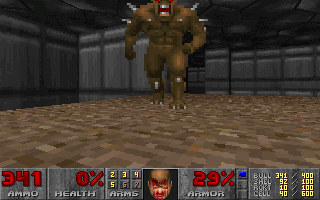
Sound-wise Doom has since become legendary for its use of stock library sound effects for pretty much all of its sounds. This is probably the reason a lot of the sounds from Doom can be heard in a multitude of other media, especially movies. Which often makes people assume the sound effects are taken from Doom, not realizing not a lot of sounds were made exclusively for Doom to begin with. Even its music is somewhat derivative, with a lot of it almost copying other works by hard rock bands such as Judas Priest and Metallica. Not that it’s necessarily a bad thing, given the music fits the game perfectly. It’s very hard to imagine Doom without its iconic soundtrack.
But there’s no doubt that from its legendary shotgun sound, to the haunting cries and roars of its demonic hordes, and its mostly silent but grunting protagonist, Doom’s soundscape is as memorable as it is perfectly fitting its setting. id Software did a lot with very little and it paid off. And with a decent sound card such as the Roland SoundCanvas or MT-32, the music sounds amazing.
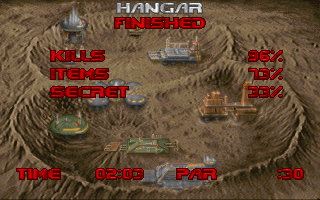
It is hard to imagine a gaming world without Doom. Doom was a groundbreaking achievement not for how well it did 3D graphics, but how well it did them for machines at the time. And while it may seem outdated and not as shocking nowadays, it is important to remember that at the time, there simply was no other game like it. It marked the beginning of an era, the true beginning of the 90’s era of gaming. With Doom came the first person shooter genre. With Doom came multiplayer, modding, and a lot of the culture we now take for granted with first person shooters. It coined terms such as fragging, deathmatches and gibs (short for giblets).
The only sad thing about Doom is really what it could’ve been. Originally it was meant to have more RPG elements, and more of a story and be a more cinematic game. The team even envisioned hub worlds that one could travel back and forth in. Imagine how groundbreaking the game could’ve truly been if the team hadn’t decided to make a pure action game. But perhaps the world was not truly ready for that yet and needed Doom as a stepping stone. Because as fun as it is, Doom is also repetitive and very little new is added in each episode. And once you have completed it in its entirety, there’s not much incentive to revisit it beyond playing mods. It’s not a game that is fun to play for long periods given its lack of story and gameplay beyond simple shooting. But it’s definitely really good at what it set out to do.
And regardless, Doom is a true classic in every sense of the word. A game that despite showing its age will continue to age like wine. Or perhaps blood. Because Doom has served as the life blood for so many following games after it. Games that will be remembered for a long time in the future. And with Doom Eternal soon showing its face, there is certainly no reason to stop celebrating this game’s 25th anniversary any time soon!
SCORE
STORY: 8/10
GAMEPLAY: 9/10
GRAPHICS: 10/10
SOUND: 10/10
FINAL SCORE: 9/10
